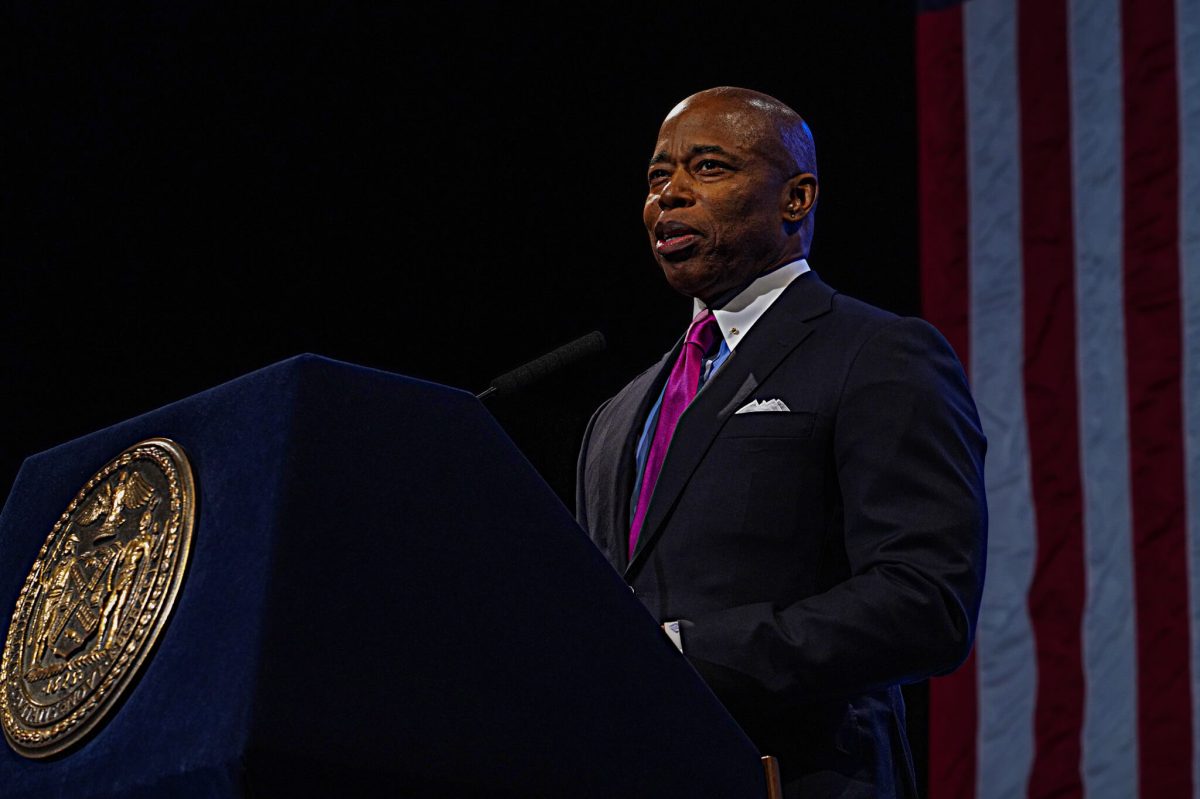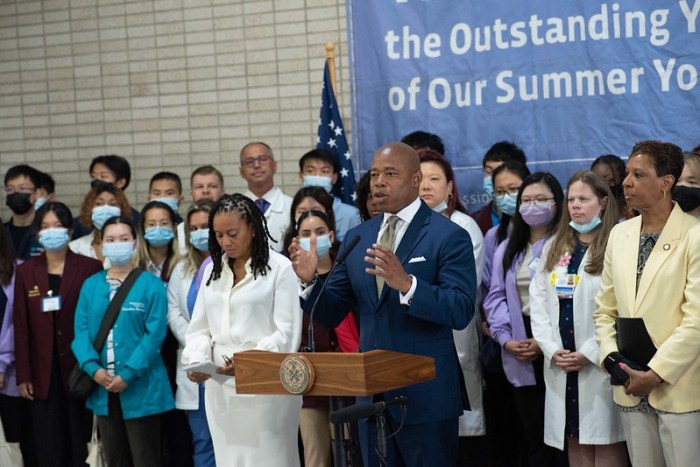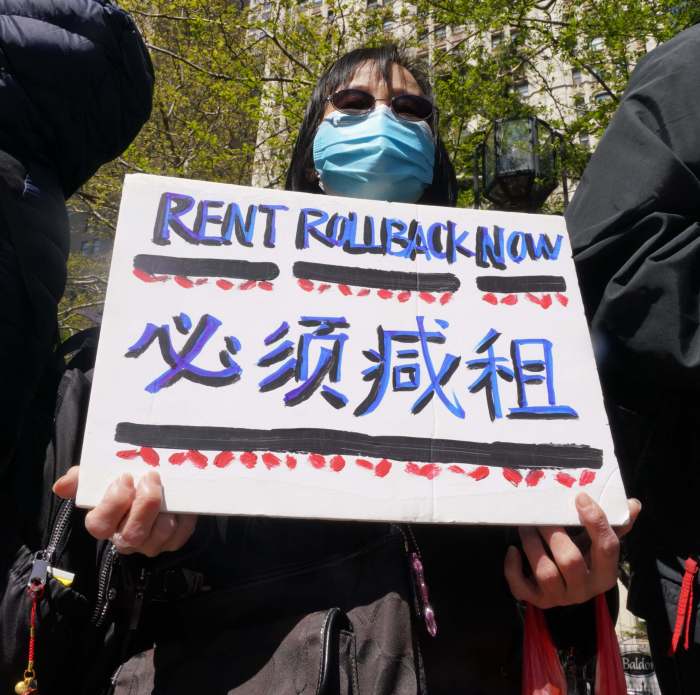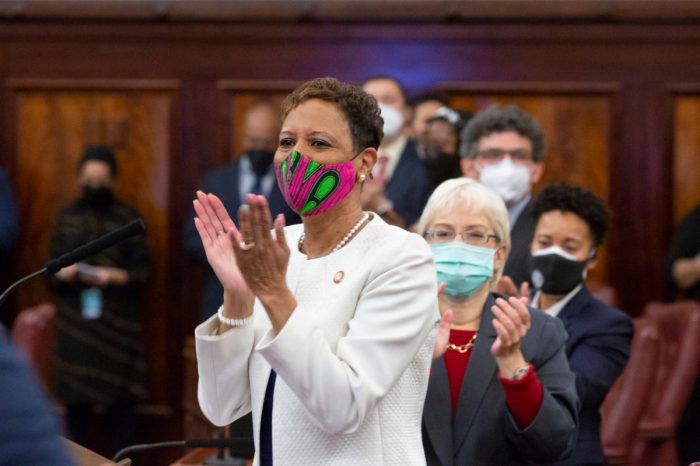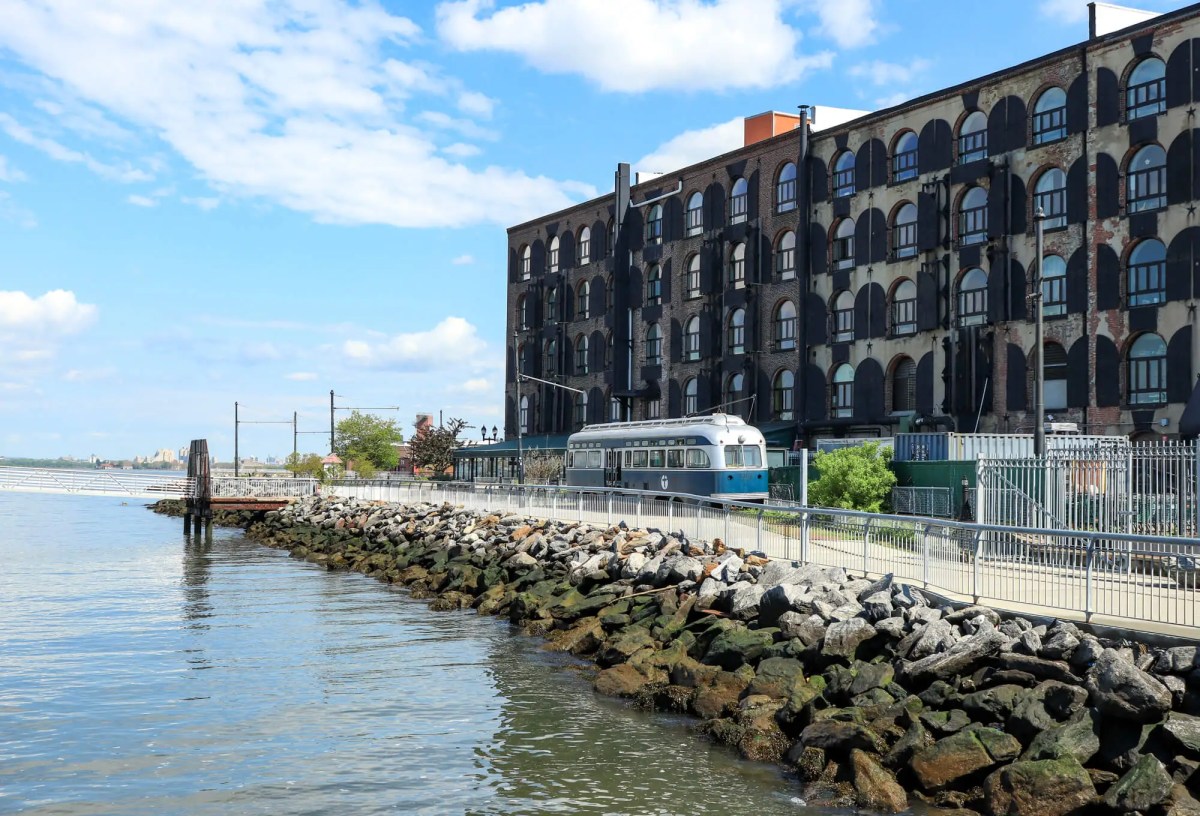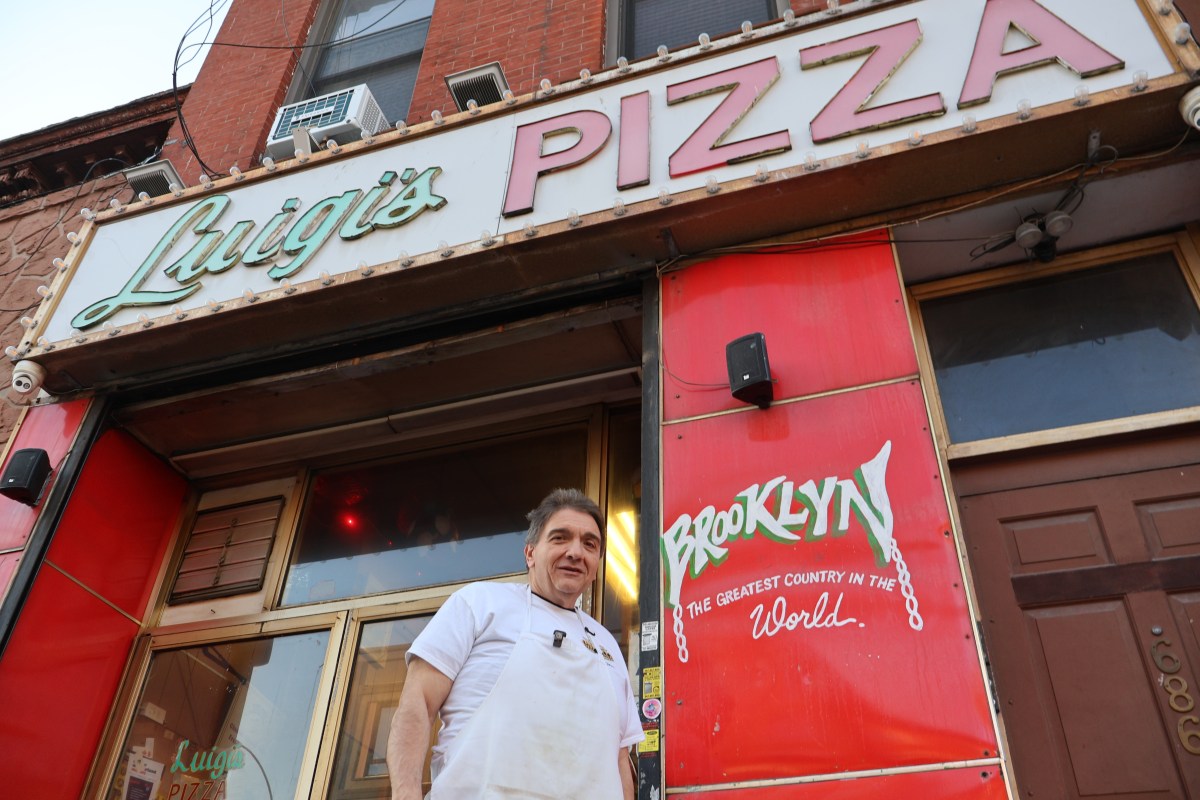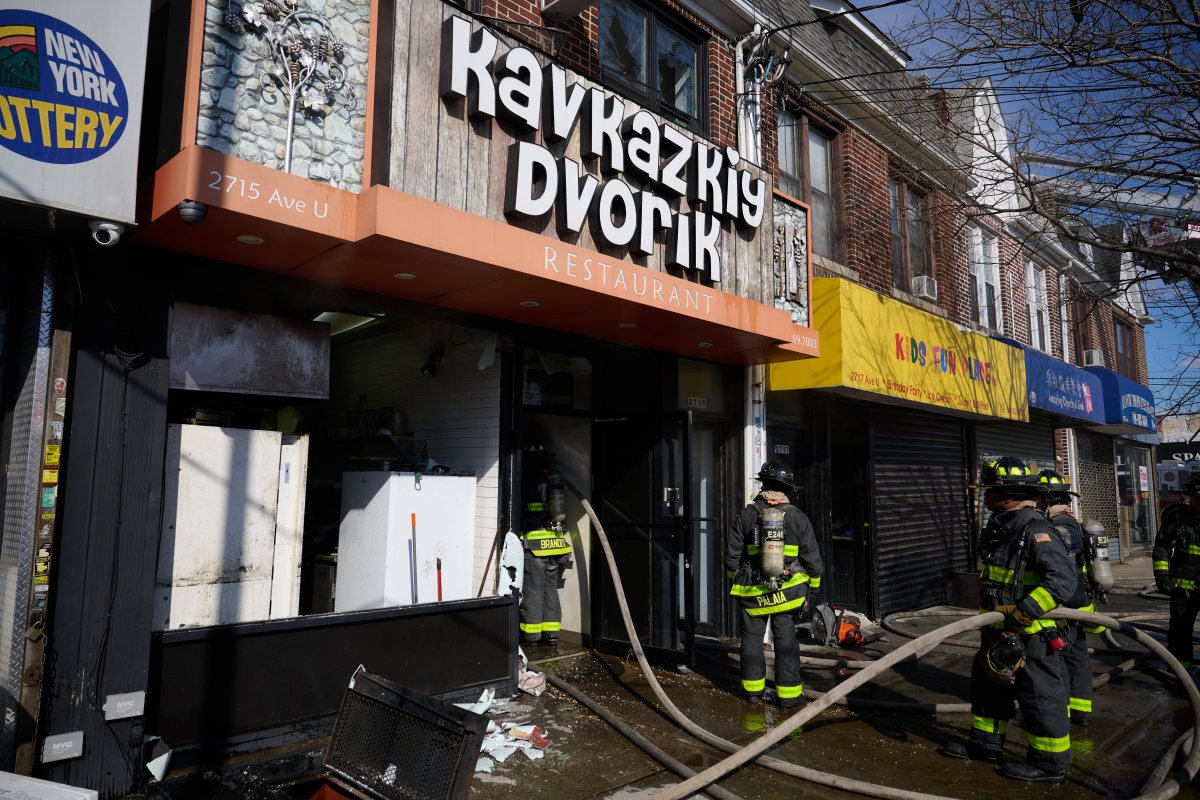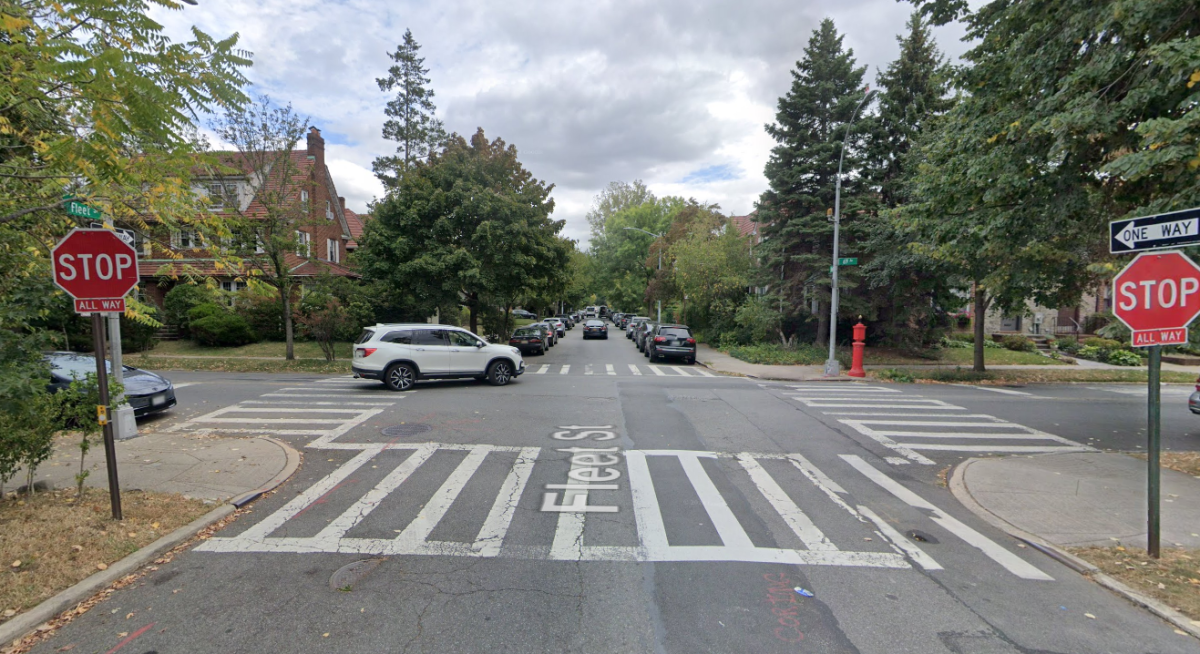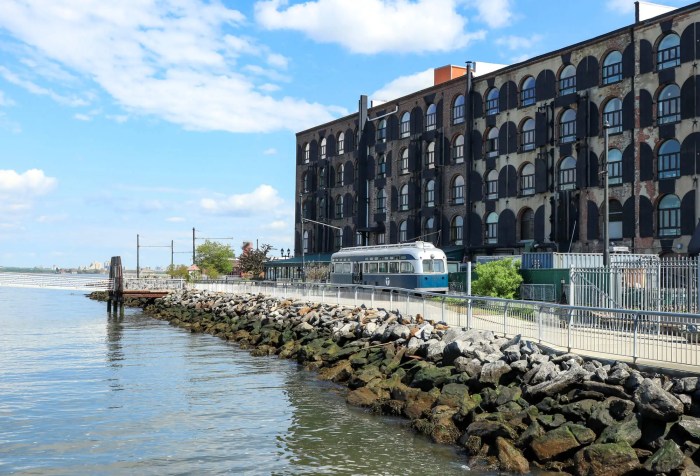In his second State of the City address on Thursday, Mayor Eric Adams laid out his vision for a “Working People’s Agenda” that will guide his administration as his sophomore year in office gets underway.
Adams delivered the annual speech at the Queens Theater in Flushing Meadows Corona Park, not even a full year after his first, pandemic-delayed State of the City at Brooklyn’s Kings Theater last April. During Thursday’s address, hizzoner laid out plans to get more New Yorkers into the workforce, take over 1,000 repeat offenders off city streets and rezoning areas like Midtown Manhattan to construct more housing under four pillars: jobs, safety, housing, and care.
The mayor started off by reflecting on the progress he feels his administration made over its first year in bringing down high crime numbers and reviving the city’s economy from the devastation wrought by the coronavirus pandemic.
“One year ago, we were facing crisis after crisis — COVID, crime, an economy in freefall,” Adams said. “One year later, our city is on the pathway to being safer, our economy is recovering, and our stores, subways, and hotels are full. Our children are back in school with their teachers and friends. Our theaters are thriving, our restaurants are booked, and New Yorkers are back to work.”
“Today, I stand before you here at the Queens Theater, in the borough where I grew up,” he continued. “Home to an international working-class community to say to you, my fellow New Yorkers: The state of our city is strong.”
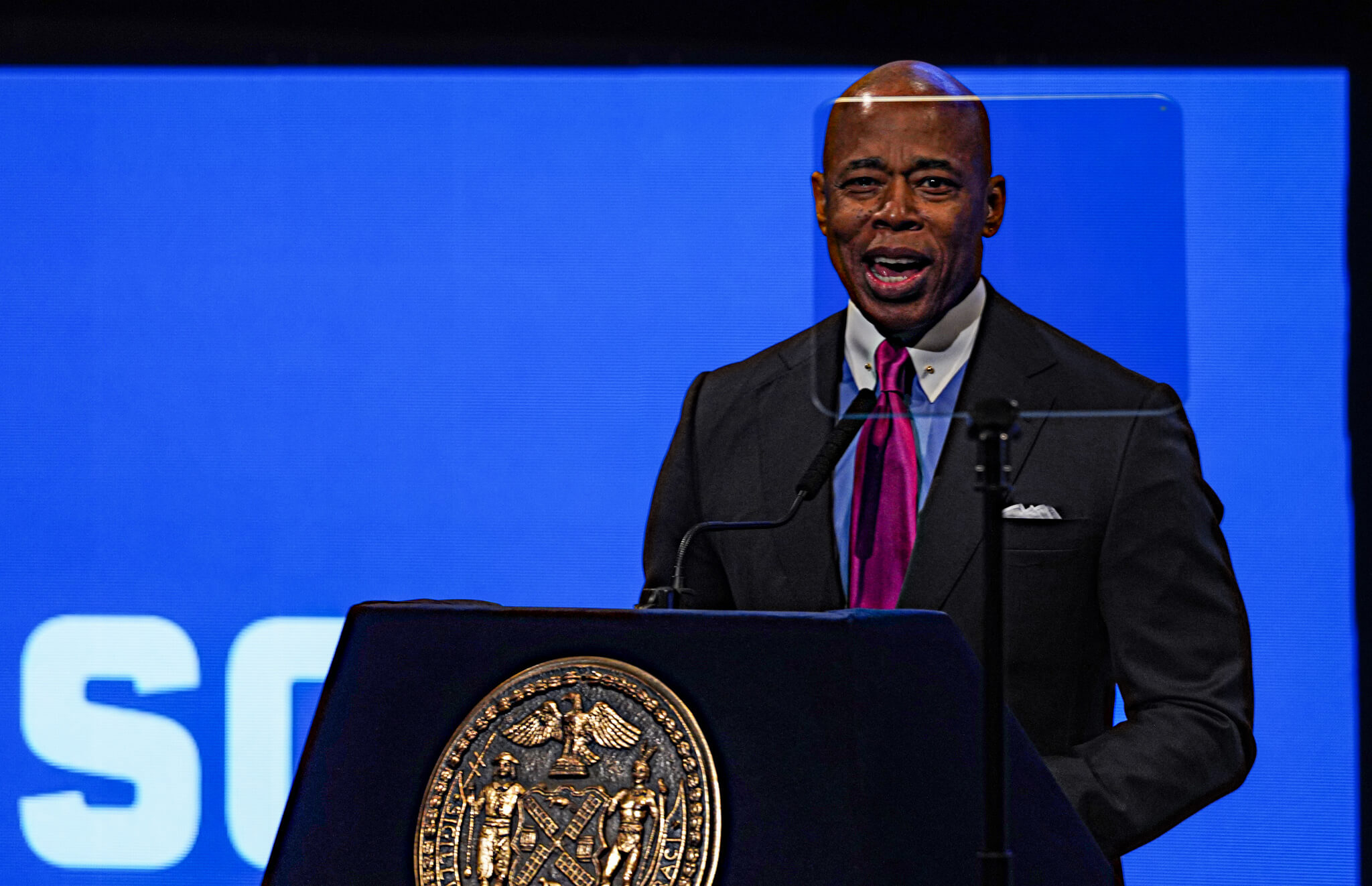
The economy
Adams kicked off his address by noting the city has gained 200,000 jobs over the past year, but that those gains don’t offset the fact that the unemployment rate among Black New Yorkers is still three times that of their white counterparts.
In order to start chipping away at that inequity, Adams unveiled a new so-called “Apprenticeship Accelerator” program to place 30,000 people in apprenticeships by 2030. The accelerator aims to provide assistance to employers, educational institutions and labor unions in being able to offer more apprenticeship opportunities, according to City Hall.
The program also seeks to broaden the range of career paths apprenticeships are offered in to include areas like information technology and health care.
“This is on-the-job experience with an opportunity for permanent employment in high demand careers, and it will ensure employers can tap the talent they need,” Adams said.
The mayor also announced a 50,000-square-foot “innovation lab” — backed by a $20 million investment from administration, according to a report from the news website The City — in the Brooklyn Navy Yard geared towards jumpstarting careers in the biotech industry. The incubator will open sometime over the next few years and provide office space, research labs and events space to foster the growth of biotech startups and companies.
The announcement of the innovation lab comes on the heels of Adams and Governor Kathy Hochul unveiling a $1.6 billion state-of-the-art life sciences hub last fall, slated for the Kips Bay section of Manhattan.
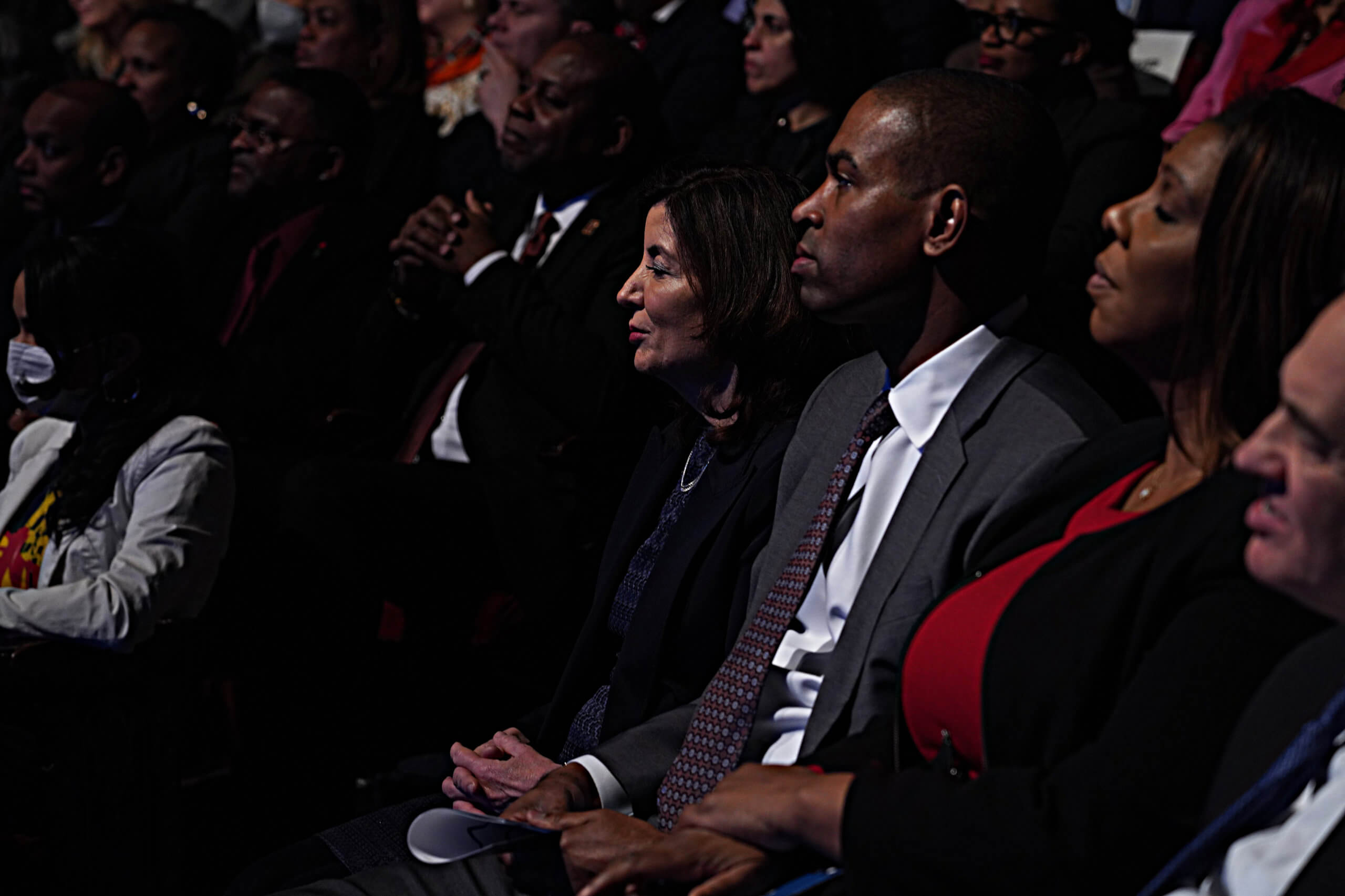
Additionally, in partnership with the City University of New York, Adams is launching a “Nursing Education Initiative” to support 30,000 nurses — both aspiring and current — over the next five years with breaking into and staying in the profession.
“Nurses are the hands, heart and soul of our healthcare system,” the mayor said. “We will never forget you and we will continue to supply you with the resources you need.”
Jonathan Bowles, executive director of the Center for an Urban Future think tank, applauded the mayor for proposals like the apprenticeship accelerator, the expansion of the CUNY2x Tech program and a “Center for Workplace Accessibility and Inclusion” to place 2,500 people with disabilities in jobs.
“The economic mobility programs that Mayor Adams announced today are exactly the steps the city should take to build a more equitable economy in New York City,” Bowles said. “By investing in the Apprenticeship Accelerator, the CUNY 2x Tech program, and programs to connect people with disabilities to high-paying jobs the city is making employment opportunities accessible to all New Yorkers.”
Crime
The mayor also devoted a good portion of his speech to an issue that took up much of his focus during his first year in office: combating crime.
Adams, a former NYPD captain, pointed to the marked decreases in shootings and murders over his first 12 months in office as a sign of the city’s improving public safety under his watch.
“Our administration came into City Hall with a mission and a mandate: Reducing gun violence. We’ve already made real progress,” Adams said. “Shootings are down, murders are down, and major crimes were down last quarter for the first time in six quarters. New Yorkers can finally see safer days ahead after several years of rising crime.”
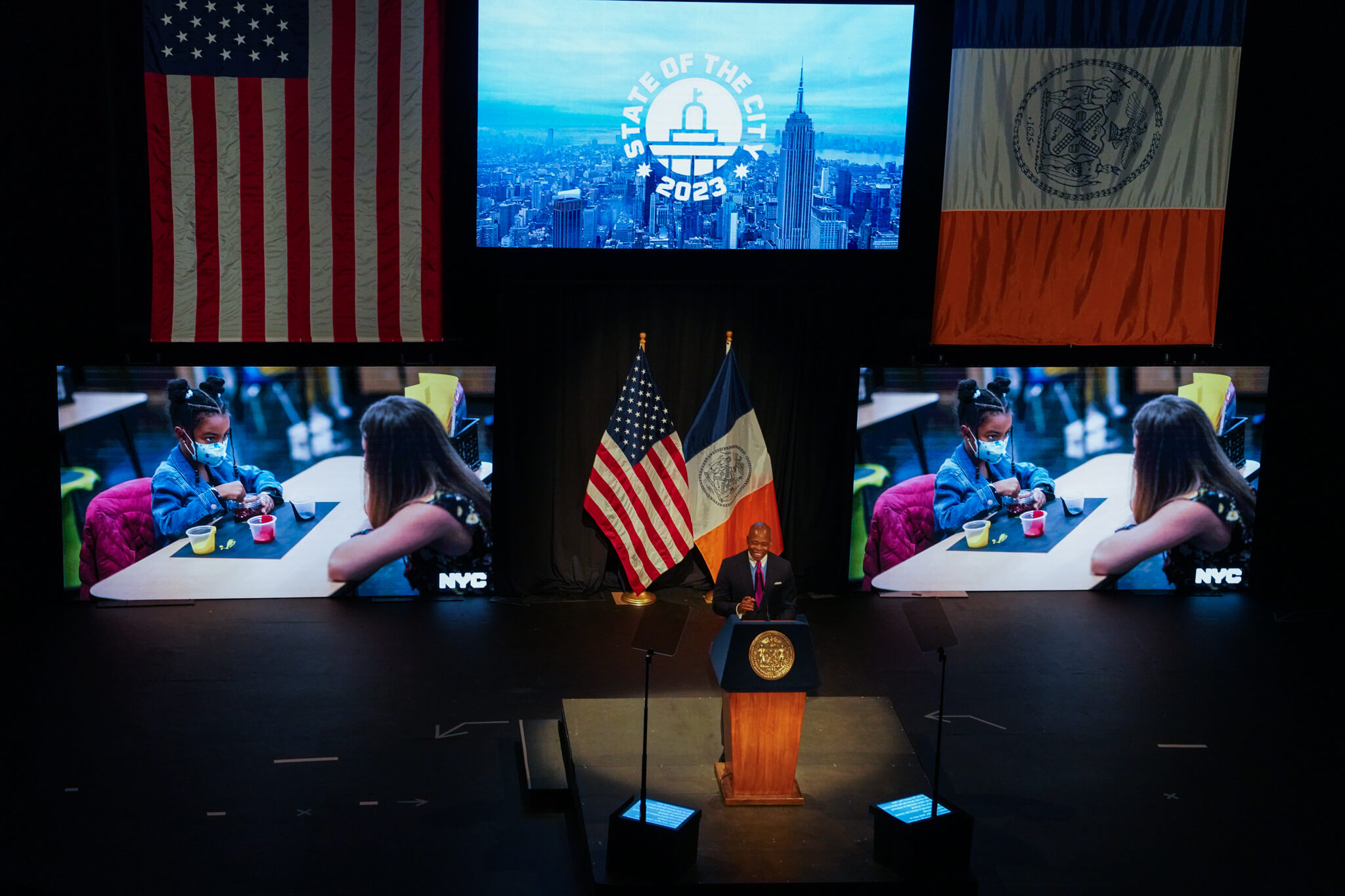
But, Adams claims a group of about 1,700 repeat offenders, whom he labeled “New York’s Most Wanted,” are responsible for a “disproportionate amount” of the city’s violent crime.
“Time after time you see crime after crime from a core group of repeat offenders,” the mayor said. “We know they are and we need to get them off our streets.”
To that end, Adams said, his administration will work with the governor and Albany lawmakers to take those recidivists off city streets. That includes freeing up backlogs in the court system by pumping more funding into the offices of the city’s five district attorneys to fill staffing vacancies.
He also called for expediting the discovery process by getting more funding into the hands of public defenders. But, at the same time, Adams is pushing for changes this state legislative session to a 2019 discovery reform intended to give defendants access to much of the evidence against them pre-trial.
“Justice delayed is justice denied,” Adams said. “Our legal system must ensure that dangerous people are kept off the streets, innocent people are not consumed by bureaucracy and victims can obtain resolution.”
The public defender group The Legal Aid Society, in a statement, applauded the mayor’s push to get more funding for groups like itself to handle the discovery process — but urged him not to seek changes to the 2019 law.
“Today’s announcement from Mayor Eric Adams of a proposed funding allocation to assist our organization with discovery obligations is welcome news, and we laud the Mayor for this action, but we categorically reject any changes to the current discovery law – rollbacks City Hall and other lawmakers will likely push for this legislative session,” the group said.
Housing
Both Adams and Hochul have made housing key pieces of their agendas for the coming year, each of them releasing ambitious plans to construct hundreds of thousands of units over the next decade — 500,000 at the city level and 800,000 statewide.
In order to reach his “moonshot goal” of constructing 500,000 new units of housing over the next 10 years, Adams said the city will pursue rezonings in areas like Midtown Manhattan, so manufacturing and office space can be converted for residential use. Adams said City Council Members Erik Bottcher, who represents the west side of Midtown, and Keith Powers, who represents the eastern portion of the area, are already on board with a potential rezoning.
“This is a critical time in the city to expand housing, so it’s essential that we look at areas in the heart of Midtown — a transit rich area with lots of opportunity,” Powers said in a statement to amNewYork Metro. “That’s why today’s announcement to evaluate the Garment District is exciting news.”
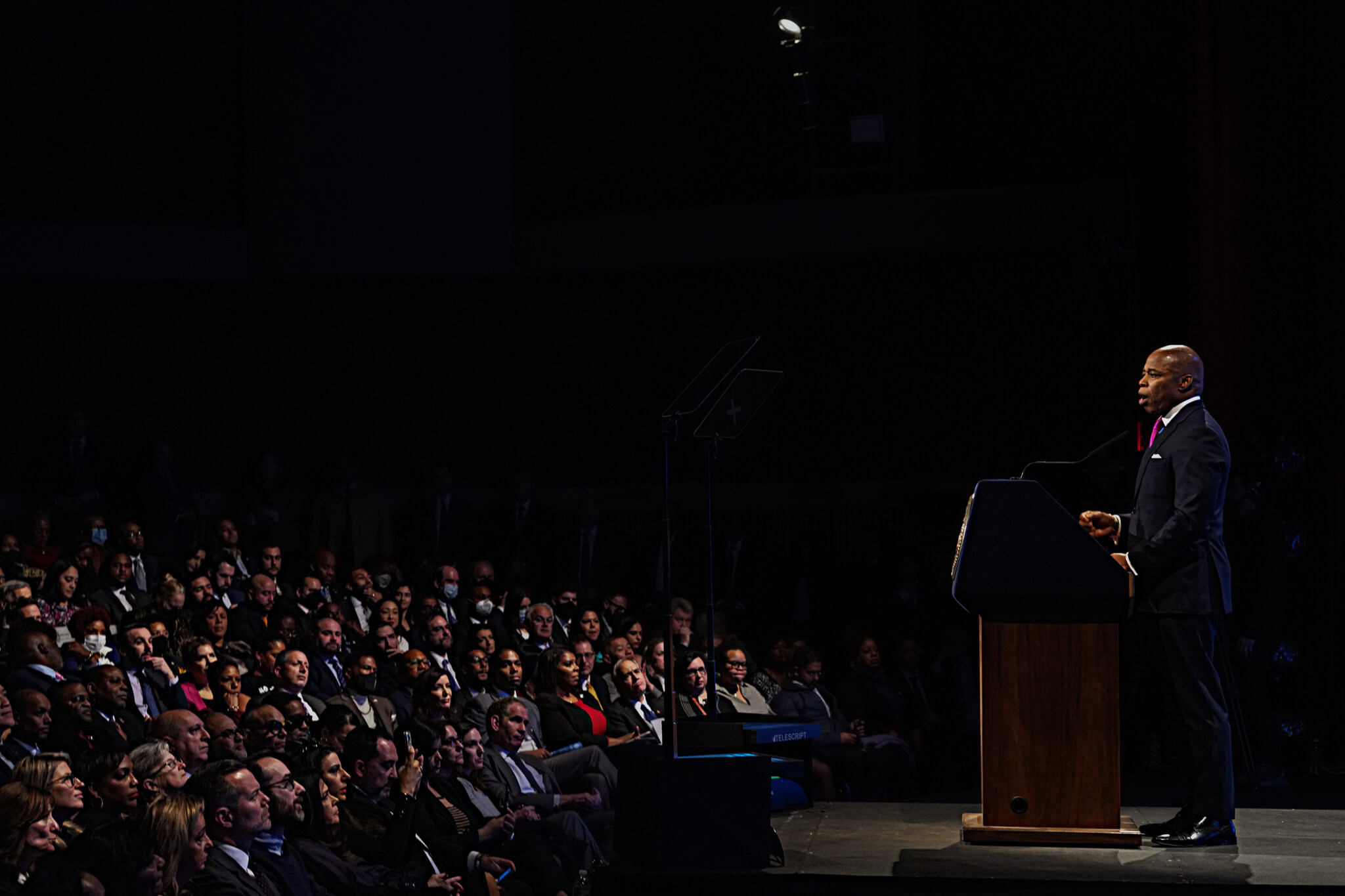
Adams said he’s also looking to partner with City Council Member Kamillah Hanks (D-Staten Island) on rezoning the north shore of Staten Island for flood resiliency, job creation and mixed use development.
While many of the mayor’s proposals in his address align with the council’s, Council Speaker Adrienne Adams said in a statement, none of it can be accomplished without the necessary funding. And that’s money the mayor currently isn’t investing, as he made across-the-board cuts in his preliminary budget earlier this month.
“At the end of the day, budget commitments are necessary to achieve our goals,” the speaker said. “None of this work is possible without the full capacity of our city agencies that have lost funding, struggled with dangerously high rates of vacancies, and are at risk of losing additional funds and positions. This has undermined the ability to truly confront the housing crisis and deliver essential services to New Yorkers, making it difficult for the city to properly fund housing projects and New Yorkers to access assistance like their SNAP benefits and housing vouchers. To successfully implement the jobs, safety, housing, and care laid out in Mayor Adams’ State of the City, the necessary investments must follow.”



